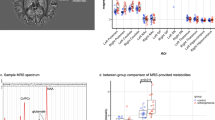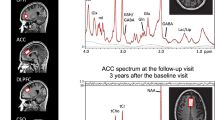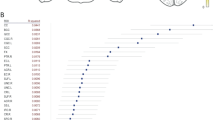Abstract
Abnormal metabolism has been reported in bipolar disorder, however, these studies have been limited to specific regions of the brain. To investigate whole-brain changes potentially associated with these processes, we applied a magnetic resonance imaging technique novel to psychiatric research, quantitative mapping of T1 relaxation in the rotating frame (T1ρ). This method is sensitive to proton chemical exchange, which is affected by pH, metabolite concentrations and cellular density with high spatial resolution relative to alternative techniques such as magnetic resonance spectroscopy and positron emission tomography. Study participants included 15 patients with bipolar I disorder in the euthymic state and 25 normal controls balanced for age and gender. T1ρ maps were generated and compared between the bipolar and control groups using voxel-wise and regional analyses. T1ρ values were found to be elevated in the cerebral white matter and cerebellum in the bipolar group. However, volumes of these areas were normal as measured by high-resolution T1- and T2-weighted magnetic resonance imaging. Interestingly, the cerebellar T1ρ abnormalities were normalized in participants receiving lithium treatment. These findings are consistent with metabolic or microstructural abnormalities in bipolar disorder and draw attention to roles of the cerebral white matter and cerebellum. This study highlights the potential utility of high-resolution T1ρ mapping in psychiatric research.
This is a preview of subscription content, access via your institution
Access options
Subscribe to this journal
Receive 12 print issues and online access
$259.00 per year
only $21.58 per issue
Buy this article
- Purchase on Springer Link
- Instant access to full article PDF
Prices may be subject to local taxes which are calculated during checkout



Similar content being viewed by others
References
Stork C, Renshaw PF . Mitochondrial dysfunction in bipolar disorder: evidence from magnetic resonance spectroscopy research. Mol Psychiatry 2005; 10: 900–919.
Kato T, Kato N . Mitochondrial dysfunction in bipolar disorder. Bipolar Disord 2000; 2: 180–190.
Vawter MP, Tomita H, Meng F, Bolstad B, Li J, Evans S et al. Mitochondrial-related gene expression changes are sensitive to agonal-pH state: implications for brain disorders. Mol Psychiatry 2006; 11: 663–679.
Kato T . Mitochondrial dysfunction as the molecular basis of bipolar disorder: therapeutic implications. CNS Drugs 2007; 21: 1–11.
Clay HB, Sillivan S, Konradi C . Mitochondrial dysfunction and pathology in bipolar disorder and schizophrenia. Int J Dev Neurosci 2011; 29: 311–324.
Kato T, Murashita J, Kamiya A, Shioiri T, Kato N, Inubushi T . Decreased brain intracellular pH measured by 31P-MRS in bipolar disorder: a confirmation in drug-free patients and correlation with white matter hyperintensity. Eur Arch Psychiatry Clin Neurosci 1998; 248: 301–306.
Beyer JL, Young R, Kuchibhatla M, Krishnan KR . Hyperintense MRI lesions in bipolar disorder: A meta-analysis and review. Int Rev Psychiatry 2009; 21: 394–409.
Gunde E, Blagdon R, Hajek T . White matter hyperintensities: from medical comorbidities to bipolar disorders and back. Ann Med 2011; 43: 571–580.
Heng S, Song AW, Sim K . White matter abnormalities in bipolar disorder: insights from diffusion tensor imaging studies. J Neural Transm 2010; 117: 639–654.
Emsell L, Langan C, Van Hecke W, Barker GJ, Leemans A, Sunaert S et al. White matter differences in euthymic bipolar I disorder: a combined magnetic resonance imaging and diffusion tensor imaging voxel-based study. Bipolar Disord 2013; 15: 365–376.
Stertz L, Magalhaes PV, Kapczinski F . Is bipolar disorder an inflammatory condition? The relevance of microglial activation. Curr Opin Psychiatry 2013; 26: 19–26.
Kim S, Webster MJ . Correlation analysis between genome-wide expression profiles and cytoarchitectural abnormalities in the prefrontal cortex of psychiatric disorders. Mol Psychiatry 2010; 15: 326–336.
Konradi C, Sillivan SE, Clay HB . Mitochondria, oligodendrocytes and inflammation in bipolar disorder: evidence from transcriptome studies points to intriguing parallels with multiple sclerosis. Neurobiol Dis 2012; 45: 37–47.
Berk M, Kapczinski F, Andreazza AC, Dean OM, Giorlando F, Maes M et al. Pathways underlying neuroprogression in bipolar disorder: focus on inflammation, oxidative stress and neurotrophic factors. Neurosci Biobehav Rev 2011; 35: 804–817.
Schneider MR, DelBello MP, McNamara RK, Strakowski SM, Adler CM . Neuroprogression in bipolar disorder. Bipolar Disord 2012; 14: 356–374.
Oz G, Alger JR, Barker PB, Bartha R, Bizzi A, Boesch C et al. Clinical proton MR spectroscopy in central nervous system disorders. Radiology 2014; 270: 658–679.
Phelps ME . PET: the merging of biology and imaging into molecular imaging. J Nucl Med 2000; 41: 661–681.
Sepponen RE, Pohjonen JA, Sipponen JT, Tanttu JI . A method for T1rho imaging. J Comput Assist Tomogr 1985; 9: 1007–1011.
Jin T, Autio J, Obata T, Kim SG . Spin-locking versus chemical exchange saturation transfer MRI for investigating chemical exchange process between water and labile metabolite protons. Magn Reson Med 2011; 65: 1448–1460.
Kettunen MI, Grohn OH, Silvennoinen MJ, Penttonen M, Kauppinen RA . Effects of intracellular pH, blood, and tissue oxygen tension on T1rho relaxation in rat brain. Magn Reson Med 2002; 48: 470–477.
Michaeli S, Burns TC, Kudishevich E, Harel N, Hanson T, Sorce DJ et al. Detection of neuronal loss using T1rho MRI assessment of 1H2O spin dynamics in the aphakia mouse. J Neurosci Methods 2009; 177: 160–167.
Magnotta VA, Heo HY, Dlouhy BJ, Dahdaleh NS, Follmer RL, Thedens DR et al. Detecting activity-evoked pH changes in human brain. Proc Natl Acad Sci USA 2012; 109: 8270–8273.
Jin T, Kim SG . Characterization of non-hemodynamic functional signal measured by spin-lock fMRI. Neuroimage 2013; 78: 385–395.
Jin T, Mehrens H, Hendrich KS, Kim SG . Mapping brain glucose uptake with chemical exchange-sensitive spin-lock magnetic resonance imaging. J Cereb Blood Flow Metab 2014; 34: 1402–1410.
Charagundla SR, Borthakur A, Leigh JS, Reddy R . Artifacts in T1rho-weighted imaging: correction with a self-compensating spin-locking pulse. J Magn Reson 2003; 162: 113–121.
Pierson R, Johnson H, Harris G, Keefe H, Paulsen JS, Andreasen NC et al. Fully automated analysis using BRAINS: AutoWorkup. Neuroimage 2011; 54: 328–336.
Halle M, Talos I-F, Jakab M, Makris N, Meier D, Wald L et al Multi-modality MRI-based atlas of the brain. SPL: Boston, MA, 2013; URL: http://www.spl.harvard.edu/publications/item/view/2037.
Avants BB, Tustison NJ, Song G, Cook PA, Klein A, Gee JC . A reproducible evaluation of ANTs similarity metric performance in brain image registration. Neuroimage 2011; 54: 2033–2044.
Mori S, Oishi K, Jiang H, Jiang L, Li X, Akhter K et al. Stereotaxic white matter atlas based on diffusion tensor imaging in an ICBM template. Neuroimage 2008; 40: 570–582.
Cox RW . AFNI: software for analysis and visualization of functional magnetic resonance neuroimages. Comput Biomed Res 1996; 29: 162–173.
Watts R, Andrews T, Hipko S, Gonyea JV, Filippi CG . In vivo whole-brain T1-rho mapping across adulthood: normative values and age dependence. J Magn Reson Imaging 2014; 40: 376–382.
R Core Team R: A language and environment for statistical computing. R Foundation for Statistical Computing: Vienna, Austria, 2013; URL: http://www.R-project.org/.
Kapczinski F, Dal-Pizzol F, Teixeira AL, Magalhaes PV, Kauer-Sant'Anna M, Klamt F et al. Peripheral biomarkers and illness activity in bipolar disorder. J Psychiatr Res 2011; 45: 156–161.
Brambilla P, Bellani M, Yeh PH, Soares JC, Tansella M . White matter connectivity in bipolar disorder. Int Rev Psychiatry 2009; 21: 380–386.
Emsell L, McDonald C . The structural neuroimaging of bipolar disorder. Int Rev Psychiatry 2009; 21: 297–313.
Marlinge E, Bellivier F, Houenou J . White matter alterations in bipolar disorder: potential for drug discovery and development. Bipolar Disord 2014; 16: 97–112.
Langan C, McDonald C . Neurobiological trait abnormalities in bipolar disorder. Mol Psychiatry 2009; 14: 833–846.
Hamakawa H, Murashita J, Yamada N, Inubushi T, Kato N, Kato T . Reduced intracellular pH in the basal ganglia and whole brain measured by 31P-MRS in bipolar disorder. Psychiatry Clin Neurosci 2004; 58: 82–88.
Hosokawa T, Momose T, Kasai K . Brain glucose metabolism difference between bipolar and unipolar mood disorders in depressed and euthymic states. Prog Neuropsychopharmacol Biol Psychiatry 2009; 33: 243–250.
Altamura AC, Bertoldo A, Marotta G, Paoli RA, Caletti E, Dragogna F et al. White matter metabolism differentiates schizophrenia and bipolar disorder: a preliminary PET study. Psychiatry Res 2013; 214: 410–414.
Andreasen NC, Pierson R . The role of the cerebellum in schizophrenia. Biol Psychiatry 2008; 64: 81–88.
Hoppenbrouwers SS, Schutter DJ, Fitzgerald PB, Chen R, Daskalakis ZJ . The role of the cerebellum in the pathophysiology and treatment of neuropsychiatric disorders: a review. Brain Res Rev 2008; 59: 185–200.
Kim D, Cho HB, Dager SR, Yurgelun-Todd DA, Yoon S, Lee JH et al. Posterior cerebellar vermal deficits in bipolar disorder. J Affect Disord 2013; 150: 499–506.
Loeber RT, Sherwood AR, Renshaw PF, Cohen BM, Yurgelun-Todd DA . Differences in cerebellar blood volume in schizophrenia and bipolar disorder. Schizophr Res 1999; 37: 81–89.
Loeber RT, Gruber SA, Cohen BM, Renshaw PF, Sherwood AR, Yurgelun-Todd DA . Cerebellar blood volume in bipolar patients correlates with medication. Biol Psychiatry 2002; 51: 370–376.
Bolbecker AR, Mehta C, Johannesen JK, Edwards CR, O'Donnell BF, Shekhar A et al. Eyeblink conditioning anomalies in bipolar disorder suggest cerebellar dysfunction. Bipolar Disord 2009; 11: 19–32.
Bolbecker AR, Hong SL, Kent JS, Forsyth JK, Klaunig MJ, Lazar EK et al. Paced finger-tapping abnormalities in bipolar disorder indicate timing dysfunction. Bipolar Disord 2011; 13: 99–110.
Bolbecker AR, Hong SL, Kent JS, Klaunig MJ, O'Donnell BF, Hetrick WP . Postural control in bipolar disorder: increased sway area and decreased dynamical complexity. PLoS One 2011; 6: e19824.
Kohno T, Shiga T, Toyomaki A, Kusumi I, Matsuyama T, Inoue T et al. Effects of lithium on brain glucose metabolism in healthy men. J Clin Psychopharmacol 2007; 27: 698–702.
Forlenza OV, Coutinho AM, Aprahamian I, Prando S, Mendes LL, Diniz BS et al. Long-term lithium treatment reduces glucose metabolism in the cerebellum and hippocampus of nondemented older adults: an [18F]FDG-PET study. ACS Chem Neurosci e-pub ahead of print 29 April 2014. doi:2010.1021/cn5000315.
Can A, Schulze TG, Gould TD . Molecular actions and clinical pharmacogenetics of lithium therapy. Pharmacol Biochem Behav 2014; 123: 3–16.
Deoni SC . Quantitative relaxometry of the brain. Top Magn Reson Imaging 2010; 21: 101–113.
Mangia S, Liimatainen T, Garwood M, Michaeli S . Rotating frame relaxation during adiabatic pulses vs conventional spin lock: simulations and experimental results at 4 T. Magn Reson Imaging 2009; 27: 1074–1087.
Borthakur A, Wheaton AJ, Gougoutas AJ, Akella SV, Regatte RR, Charagundla SR et al. In vivo measurement of T1rho dispersion in the human brain at 1.5 tesla. J Magn Reson Imaging 2004; 19: 403–409.
Agarwal N, Port JD, Bazzocchi M, Renshaw PF . Update on the use of MR for assessment and diagnosis of psychiatric diseases. Radiology 2010; 255: 23–41.
Witschey WR 2nd, Borthakur A, Elliott MA, Mellon E, Niyogi S, Wallman DJ et al. Artifacts in T1rho-weighted imaging: compensation for B1 and B0 field imperfections. J Magn Reson 2007; 186: 75–85.
Chen W, Takahashi A, Han E . Quantitative T1rho imaging using phase cycling for B0 and B1 field inhomogeneity compensation. Magn Reson Imaging 2011; 29: 608–619.
Li X, Han ET, Busse RF, Majumdar S . In vivo T1rho mapping in cartilage using 3D magnetization-prepared angle-modulated partitioned k-space spoiled gradient echo snapshots (3D MAPSS). Magn Reson Med 2008; 59: 298–307.
Johnson CP, Thedens DR, Magnotta VA . Precision-guided sampling schedules for efficient T1rho mapping. J Magn Reson Imaging e-pub ahead of print 29 January 2014. doi:2010.1002/jmri.24518.
Johnson CP, Follmer RL, Oguz I, Warren LA, Christensen GE, Fiedorowicz JG et al. Quantitative T1rho mapping of bipolar disorder: basal differences in euthymia. Proc 22nd Annual Meeting Intl Soc Magn Reson Med 2014; 1: 835.
Acknowledgements
This project was partially supported by a gift from Roger Koch. JGF was supported by the National Institutes of Health (1K23MH083695-01A210). JAW was supported by the Department of Veterans Affairs (Merit Award), National Institute of Mental Health (5R01MH085724), National Heart Lung and Blood Institute (R01HL113863) and a NARSAD Independent Investigator Award. Preliminary data for this study were reported in a conference abstract.60
Author information
Authors and Affiliations
Corresponding authors
Ethics declarations
Competing interests
The authors declare no conflict of interest.
Rights and permissions
About this article
Cite this article
Johnson, C., Follmer, R., Oguz, I. et al. Brain abnormalities in bipolar disorder detected by quantitative T1ρ mapping. Mol Psychiatry 20, 201–206 (2015). https://doi.org/10.1038/mp.2014.157
Received:
Revised:
Accepted:
Published:
Issue Date:
DOI: https://doi.org/10.1038/mp.2014.157
This article is cited by
-
Association between the epigenetic lifespan predictor GrimAge and history of suicide attempt in bipolar disorder
Neuropsychopharmacology (2023)
-
Distinct patterns of altered quantitative T1ρ and functional BOLD response associated with history of suicide attempts in bipolar disorder
Brain Imaging and Behavior (2022)
-
Posterior Fossa Sub-Arachnoid Cysts Observed in Patients with Bipolar Disorder: a Retrospective Cohort Study
The Cerebellum (2022)
-
Valproate inhibits mitochondrial bioenergetics and increases glycolysis in Saccharomyces cerevisiae
Scientific Reports (2020)
-
Medical Comorbidities in Bipolar Disorder
Current Psychiatry Reports (2018)



